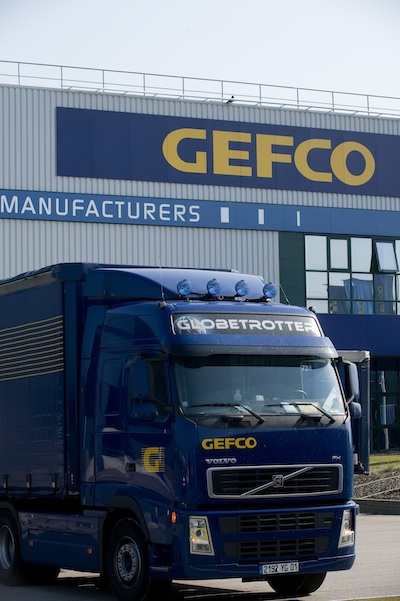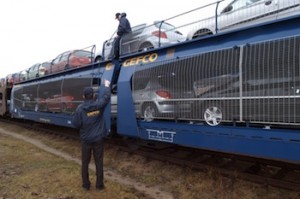Gefco’s chief executive, Luc Nadal (pictured), has ambitious plans for global expansion under Russian Railways ownership. But as an avid seaman, he knows it won’t always be smooth sailing.
 Few logistics providers have seen as much change as the Gefco Group in just two years. The major trigger was PSA Peugeot Citroën’s decision to sell part of Gefco’s capital to raise much needed cash in 2012, which led RZD Russian Railways, the giant, state-owned rail monopoly, to buy a controlling 75% share.
Few logistics providers have seen as much change as the Gefco Group in just two years. The major trigger was PSA Peugeot Citroën’s decision to sell part of Gefco’s capital to raise much needed cash in 2012, which led RZD Russian Railways, the giant, state-owned rail monopoly, to buy a controlling 75% share.
As might have been expected, Gefco’s centre of gravity has shifted eastwards. This year it opened a Moscow ‘cluster’ of sales, marketing and logistics experts that is only marginally smaller than the commercial arm of its Paris headquarters. It has reorganised regional management to better target post-Soviet Union markets from the Baltic States to Kazakhstan, a grouping Gefco calls the ‘1520 zone’ (after the different rail gauge used by these countries). Gefco expects to treble its business here by 2020, serving OEMs as well as industrial sectors like aerospace, locomotives, oil and gas.
There have been other significant shifts; Gefco is a notably more global provider with a more diversified portfolio than even two years ago. And yet, thanks to the complexities of its sale and continuing operations with PSA, nearly 70% of Gefco’s business is now technically wrapped up in two, enormous contracts.
The first is with PSA, which before the sale needed to assure potential investors that Gefco’s base business was safe. Thus, the two companies formalised their relations in 2012 with their first contract since Gefco was created in 1948. For most providers, it would have been a once-in-a-generation contract: ten years long, including a period of exclusivity, it covers PSA’s global logistics except joint venture operations.
Just a few months later, however, Gefco inked an almost equally ambitious deal with General Motors. The OEM outsourced logistics management to Gefco in a seven-year contract across 12 factories in Europe and Russia. That agreement, which also has an exclusivity period, went live April 2013. To manage the business, Gefco has installed an entirely new division, ‘4PL’, to cover network design, tendering and invoicing.
Such big changes and implementations could have upended the company’s operations and finances. But Gefco has been stable, with profitable results and no major disruptions to customers’ production or distribution, according to chairman of the management board, Luc Nadal.
Importantly, despite the new shareholder and pivot to Moscow, Gefco’s business culture remains rooted in Western Europe, with a focus on network design, IT and value-added services. That was no guarantee before it came under RZD’s vast web of management and assets. But Nadal says RZD has not tried to change Gefco’s governance model or ‘asset light’ strategy. “We feel good inside the RZD group,” he says.
Nadal even sees a greater role for Gefco to spread its culture within the larger company – it has created a ‘Gefco Academy’ in Paris, for example, to train young Russian managers.

While Gefco’s business has been strong, the recent changes have also pushed it into riskier territories, both geographically and commercially. Russia offers huge potential growth, but the Ukraine crisis certainly illustrates the region’s political and economic risks. Harsher US and EU sanctions and economic fallout, for example, could hurt both Gefco’s reputation (considering its owners) and operations in the Russian market, notably trade between Europe and Russia.
Gefco’s mega-contracts with PSA and with GM also come with obvious risks. Both carmakers have been hit badly by the European slowdown and are cutting jobs, plants and model lines. Lowering logistics costs is a priority. The PSA contract reduced Gefco’s rates, for example, while the 4PL arrangement must bring GM savings to be viable.
“With PSA, there is clearly increasing pressure on logistics costs – every euro counts,” says Nadal.
The provider must also look ahead to a not-so-distance future when the exclusivity clauses end for both contracts. It is too early to suggest PSA or GM would make major changes, especially to well-run and highly complicated operations (PSA also retains a 25% share in Gefco). Nonetheless, the logistics market will be wide open for both OEMs, and Gefco must be as competitive as any provider, and simultaneously less dependent on either contract.
Soif pour la pression
Luc Nadal understands these dilemmas and opportunities well. A 25-year logistics veteran, he also led cargo subsidiaries at another state rail operator, France’s SNCF. Since taking the helm at Gefco two years ago, he has worked frantically to shore up core business and expand elsewhere. Under Nadal, the company has opened a flurry of foreign subsidiaries, with close to 40 today including recent divisions in Mexico, Croatia, Dubai, South Africa and Algeria.
Gefco is in the midst of global growth and considerable change. See these other stories for further coverage
- Read about Gefco's ambitions and challenges in China and south-east Asia
- Gefco's 4PL contract with GM Europe means the provider is focused on integrated supply chain management. Read what this has meant at Opel/Vauxhall.
Nadal has grand visions for Gefco, including using its automotive expertise to gain customers from Russia’s huge but relatively antiquated industrial base. He wants to take 4PL services to other companies and parts of the world. He wants Gefco to be a real force in Asia and Africa.
But he is equally pragmatic about Gefco’s business strategy. Previous plans to create a multi-brand group are now outmoded, he admits, such as turning Italy’s Mercurio Group (which Gefco acquired control of in 2011) into a vehicle logistics division beyond PSA. “It doesn’t make sense today. Gefco must be one brand,” he says.
There is a potentially similar situation in Russia with Gefco’s Algai joint venture for vehicle logistics. So far, Gefco plans to keep the JV, but in the long run it may make a change. “It has been a very strong partnership with Algai and we want to be respectful. But the purpose of its original creation – to have independence from PSA in Russia – has disappeared,” Nadal says.
There are also business areas he won’t touch, such as ecommerce home delivery (messagerie in French), despite its growth. “Messagerie is highly industrialised for companies involved in B2C [business to consumer] ecommerce,” he explains. “If you don’t have ten clients on the same street to make up for missed deliveries, forget it. That is not Gefco’s business.”
Perhaps most important in the current Gefco era, Nadal is fiercely competitive. He wants to double global revenue to €8 billion ($11 billion) by 2020. And he wants much of that growth to come outside of PSA, with the OEM’s targeted share of revenue less than 30% compared to 50% today.
Nadal strives to instil a highly competitive spirit at Gefco, something he himself seems to derive from sailing. Between a busy work schedule and family life with four children, Nadal competes semi-professionally. Last year, his four-member crew placed second at the J80 World Championship in Marseilles, beating teams that included Olympic medallists.
Nadal’s language and strategies are full of sailing analogies, including the necessity of working as a team and having the drive to win. His business motto comes from a young sailing compatriot, who was in first place during the Tour de France à la Voile (a major sailing competition) and ahead by a single point at the final stages. “You’re under a lot of pressure,” Nadal told the young man. The sailor replied: “Luc, la pression, on la boit.” It translates literally as “we drink pressure”, but in French pression is also the word for draught beer.
“I tell my Gefco teams to take that attitude,” Nadal says. “So many people are going to put pressure on you that it will seem overwhelming. But if you can drink and live off it, you’ll look at life differently.”
Opening doors in Russia
Among the high-pressure areas for Gefco has been adjusting to the new shareholder. While there have been adjustments, Nadal says that Gefco has more scope under RZD control than it did in some ways with PSA. For example, while it will eventually pay a dividend, Gefco can invest more in its own expansion, including acquisitions. “In the past, PSA often needed our cash and profits,” he says. “On balance it is more understandable that a carmaker will choose to open a new plant or develop new models rather than let Gefco expand in a new country.”
For some carmakers, Gefco’s independence from PSA was reassuring in that they no longer feared favouritism, says Phil Shankley, director of business development and marketing. He points to expanding potential business with a number of carmakers, including Renault Nissan, in Europe and Russia as an example.
RZD can also open doors to other businesses in Russia and its neighbours, according to Nadal. That includes local carmakers in the region, but also the oil industry, aerospace, agricultural equipment and train wagon manufacturers.

Nadal is not naïve about these opportunities either, particularly Russian manufacturers that might have little concept of competitive logistics. “An open door alone does not create business. Some of these are highly vertically integrated companies,” he says. “But we are seeing attitudes to outsourcing begin to change.”
Nadal is also realistic about the fallout of the still unfolding Ukraine crisis. The Russian market is already weak, and the falling rouble will make things worse. The Ukrainian economy is in shambles. Furthermore, US sanctions aimed at powerful Russians have already included RZD chairman Vladimir Yakunin, although he is so far not on the EU list.
Regardless, the logistics provider is not pulling back investment in the ‘1520’ region. Along with the Moscow cluster, millions of euros have just been spent on a vehicle compound outside Moscow. Gefco is also trying to establish a block train service between Russia and China. “We are sticking to our strategy, and we’re in it for the long term in Russia,” Nadal says.
Building a central logistics engineering team
The other great realignment has been the GM Europe business, for which Gefco 4PL has absorbed logistics functions, consolidation centres and some GM executives.
Creating a central purchasing organisation has been particularly complex, as Gefco needed to build a 'Chinese wall' to ensure Gefco assets were not favoured over other bidders. The 4PL department is on a separate floor at Gefco’s headquarters with special security access. Systems are firewalled. GM has right of audit, which it uses, says Nadal.
"I tell my Gefco teams...So many people are going to put pressure on you that it will seem overwhelming. But if you can drink and live off it, you’ll look at life differently" - Luc Nadal, Gefco Group
While this protection is necessary, the point of Gefco 4PL is to combine volumes and take advantage of its scale across trade lanes. Gefco has thus created inbound and outbound engineering centres to study routes across the company. These centres have as clients Gefco 4PL, the Gefco entity responsible for PSA (CPSA) and the company’s major accounts division. Engineers can look across Gefco data that the commercial departments cannot.
The 4PL division has also just launched a freight audit and pay system for all carriers, with Gefco operations treated as any other.
 Luc Nadal says that saving costs for GM's logistics won't just be about purchasing power, but principally about re-engineering the network
Luc Nadal says that saving costs for GM's logistics won't just be about purchasing power, but principally about re-engineering the networkGefco’s goal for GM, of course, is ultimately to reduce costs. The carmaker has a target of cutting its global logistics budget by $1 billion within four years. For Gefco to help GM reach the European target, Nadal believes that Gefco must do more than exert purchasing power and lower rates. Logistics engineering will be fundamental, he says. For example, both PSA and Toyota use a high share of milkrun collections for their inbound logistics, while GM has relied more on regional consolidation centres. “We think GM can improve this, but it has to be thought of in the context of the supplier footprint,” says Nadal.
The closure of Opel’s Bochum plant in Germany offers an opportunity to relocate suppliers as models move to other plants, something GM’s supply chain planning team is working on. Nadal says that in any assessment of locations, a supplier’s economy of scale and delivery efficiency should be considered.
“The supplier might be able to produce efficiently from one plant, which means longer distances for some customers. The key thing is to synchronise the collections,” says Nadal. “Some OEMs want to reduce their collection times as they reduce output, but you need to make sure that you’re not picking up from one plant Monday and another Tuesday when you used to get both the same day. These changes need to be considered across a network.”
The future with PSA
CPSA (Client PSA), Gefco’s specific client entity for Peugeot, oversees transport route design and flow management, in particular for vehicle logistics flows. For GM, however, Gefco has taken the provider relationship a step further.
 The 4PL contract with GM has made Gefco think more carefully about what it means to be a 4PL, including for PSA
The 4PL contract with GM has made Gefco think more carefully about what it means to be a 4PL, including for PSAPSA’s logistics purchasing remains separate from GM’s, but a 4PL format would be possible depending on Gefco’s performance and PSA’s internal strategy. “We will see what [new PSA CEO] Carlos Tavares wants,” says Nadal. “He can choose to negotiate with Gefco as a formal 4PL and cut internal logistics cost, or go another way altogether.”
Sources within PSA agree it is too early to say, although the carmaker appears to be focusing more on integrating its supply chain management rather than on logistics operations. Guy Lederer, who until recently was director of international logistics before taking a post in stock management, says that the carmaker is more concerned with improving end-to-end order visibility and production flexibility than on running logistics. He does not believe the best way to improve logistics would be to change providers, but rather to provide better data and forecasts to suppliers and carriers, including Gefco.
“Changing everything with Gefco would be a good way to lose a lot of money,” he says. “We need to get better on the data that we give to Gefco, for example, so that we can get better performance back. If we wouldn’t get that performance, then of course we would have to make other changes.”
"Changing everything with Gefco would be a good way to lose a lot of money. We need to get better on the data that we give to Gefco, for example, so that we can get better performance back." - Guy Lederer, PSA Peugeot Citroën
Lederer says PSA is looking more closely at things like the line-side parameters it chooses, such as sequencing or kitting, and maintaining stable shipping frequencies and volume, all of which would allow PSA and Gefco to design more efficient supply chains together.
“The master-slave relationship is over,” he says, referring to what PSA should provide Gefco. “We need to listen to each other to find the best solutions.”
This mentality aligns with Gefco’s 4PL visions, at least at this stage. GM Europe’s internal focus is also more on supply chain planning and order management, with Gefco controlling logistics. The company would like to replicate that division of labour elsewhere.
Sailing the seven seas
Meanwhile, Nadal is not assuming anything, and is aggressively pursing global expansion. If developing as a 4PL for PSA is one version of the future, Gefco’s China and Asia strategy is another, where the global contract already doesn’t fully apply. Gefco is investing within China, including its own joint ventures, to serve both PSA and the OEM’s new investor, Dongfeng, along with other manufacturers. Gefco has aligned its expansion in south-east Asia to the ambitions of PSA and Dongfeng, who are targeting the region for exports.
Asia and the 1520 zone are not the only emerging markets in focus. Gefco is building services in North Africa, especially Algeria. Nadal sees Gefco’s base in Dubai and Turkey as hubs to connect Middle Eastern markets like Iraq and Iran (which are also important destinations for Chinese OEMs).
 Besides Asia, Gefco is also expanding its presence in North Africa, the Middle East and Mexico
Besides Asia, Gefco is also expanding its presence in North Africa, the Middle East and MexicoGefco’s focus cannot only be on growth either. Its groupage business in France is still in the red. Along with Russia, India and South America have struggled, and Gefco may need to adjust its operations in some markets. The provider wants to double in size, but to succeed profitably Nadal understands that he will need to pay attention to Gefco’s customer profile, global presence and finances.
For Nadal, Gefco is sailing with strong winds, even if the waters are choppy. The pressure, most definitely, is on. And he and his team will need a healthy thirst for it.



































